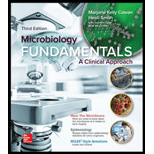
Microbiology Fundamentals: A Clinical Approach
3rd Edition
ISBN: 9781259709227
Author: Marjorie Kelly Cowan Professor, Heidi Smith
Publisher: McGraw-Hill Education
expand_more
expand_more
format_list_bulleted
Question
Chapter 11.2, Problem 7AYP
Summary Introduction
To enlist:
Several portal of entry and exit.
Concept introduction:
Microbes that can cause disease are termed as pathogens or the infectious causative agents. Microorganisms are harmful, such as bacteria, viruses and other microorganisms which cause disease are termed as pathogens. Pathogens invade tissues of the body to infect humans, plants, and other animals. Some examples of diseases caused by pathogens are common cold, tuberculosis, cholera, and chicken pox.
Expert Solution & Answer
Want to see the full answer?
Check out a sample textbook solution
Students have asked these similar questions
glg 112 mid unit assignment Identifying melting processes
Give only the mode of inheritance consistent with all three pedigrees and only two reasons that support this, nothing more, (it shouldn't take too long)
O
Chapter 11 Solutions
Microbiology Fundamentals: A Clinical Approach
Ch. 11.1 - Prob. 1AYPCh. 11.1 - Enumerate the sites where normal biota is found in...Ch. 11.1 - Discuss how the Human Microbiome Project is...Ch. 11.1 - Prob. 2NPCh. 11.2 - Differentiate between a microbes pathogenicity and...Ch. 11.2 - Prob. 5AYPCh. 11.2 - Explain the significance of polymicrobial...Ch. 11.2 - Prob. 7AYPCh. 11.2 - Prob. 8AYPCh. 11.2 - Prob. 9AYP
Ch. 11.2 - Prob. 10AYPCh. 11.2 - Prob. 11AYPCh. 11.2 - Draw a diagram of the stages of disease in a humanCh. 11.2 - Prob. 13AYPCh. 11.2 - Prob. 14AYPCh. 11.2 - Define healthcare-associated infection, and list...Ch. 11.2 - Prob. 16AYPCh. 11.2 - Prob. 1MMCh. 11.2 - Prob. 3NPCh. 11.2 - Prob. 2MMCh. 11.2 - Prob. 4NPCh. 11.2 - Prob. 5NPCh. 11.2 - Q. Can you think of what type of incident might...Ch. 11.2 - Prob. 6NPCh. 11.3 - Summarize the goals of epidemiology, and...Ch. 11.3 - Prob. 18AYPCh. 11.3 - Prob. 19AYPCh. 11.3 - Discuss the three major types of epidemics, and...Ch. 11 - Prob. 1NPCh. 11 - Prob. 1QCh. 11 - Prob. 2QCh. 11 - Prob. 3QCh. 11 - Prob. 4QCh. 11 - Prob. 5QCh. 11 - Discuss the role of endospores in ensuring the...Ch. 11 - Prob. 7QCh. 11 - Correlate the stages in the course of an...Ch. 11 - Prob. 9QCh. 11 - Prob. 10QCh. 11 - Prob. 11QCh. 11 - Prob. 12QCh. 11 - Prob. 13QCh. 11 - Prob. 14QCh. 11 - Prob. 15QCh. 11 - Prob. 16QCh. 11 - Prob. 17QCh. 11 - Prob. 18QCh. 11 - The number of cases, including new cases as well...Ch. 11 - Prob. 20QCh. 11 - One important way to critically analyze a study...Ch. 11 - Prob. 1VC
Knowledge Booster
Similar questions
- Describe the principle of homeostasis.arrow_forwardExplain how the hormones of the glands listed below travel around the body to target organs and tissues : Pituitary gland Hypothalamus Thyroid Parathyroid Adrenal Pineal Pancreas(islets of langerhans) Gonads (testes and ovaries) Placentaarrow_forwardWhat are the functions of the hormones produced in the glands listed below: Pituitary gland Hypothalamus Thyroid Parathyroid Adrenal Pineal Pancreas(islets of langerhans) Gonads (testes and ovaries) Placentaarrow_forward
- Describe the hormones produced in the glands listed below: Pituitary gland Hypothalamus Thyroid Parathyroid Adrenal Pineal Pancreas(islets of langerhans) Gonads (testes and ovaries) Placentaarrow_forwardPlease help me calculate drug dosage from the following information: Patient weight: 35 pounds, so 15.9 kilograms (got this by dividing 35 pounds by 2.2 kilograms) Drug dose: 0.05mg/kg Drug concentration: 2mg/mLarrow_forwardA 25-year-old woman presents to the emergency department with a 2-day history of fever, chills, severe headache, and confusion. She recently returned from a trip to sub-Saharan Africa, where she did not take malaria prophylaxis. On examination, she is febrile (39.8°C/103.6°F) and hypotensive. Laboratory studies reveal hemoglobin of 8.0 g/dL, platelet count of 50,000/μL, and evidence of hemoglobinuria. A peripheral blood smear shows ring forms and banana-shaped gametocytes. Which of the following Plasmodium species is most likely responsible for her severe symptoms? A. Plasmodium vivax B. Plasmodium ovale C. Plasmodium malariae D. Plasmodium falciparumarrow_forward
- please fill in missing parts , thank youarrow_forwardplease draw in the answers, thank youarrow_forwarda. On this first grid, assume that the DNA and RNA templates are read left to right. DNA DNA mRNA codon tRNA anticodon polypeptide _strand strand C с A T G A U G C A TRP b. Now do this AGAIN assuming that the DNA and RNA templates are read right to left. DNA DNA strand strand C mRNA codon tRNA anticodon polypeptide 0 A T G A U G с A TRParrow_forward
arrow_back_ios
SEE MORE QUESTIONS
arrow_forward_ios
Recommended textbooks for you
 Comprehensive Medical Assisting: Administrative a...NursingISBN:9781305964792Author:Wilburta Q. Lindh, Carol D. Tamparo, Barbara M. Dahl, Julie Morris, Cindy CorreaPublisher:Cengage Learning
Comprehensive Medical Assisting: Administrative a...NursingISBN:9781305964792Author:Wilburta Q. Lindh, Carol D. Tamparo, Barbara M. Dahl, Julie Morris, Cindy CorreaPublisher:Cengage Learning Issues and Ethics in the Helping Professions (Min...NursingISBN:9781337406291Author:Gerald Corey, Marianne Schneider Corey, Cindy CoreyPublisher:Cengage LearningSurgical Tech For Surgical Tech Pos CareHealth & NutritionISBN:9781337648868Author:AssociationPublisher:Cengage
Issues and Ethics in the Helping Professions (Min...NursingISBN:9781337406291Author:Gerald Corey, Marianne Schneider Corey, Cindy CoreyPublisher:Cengage LearningSurgical Tech For Surgical Tech Pos CareHealth & NutritionISBN:9781337648868Author:AssociationPublisher:Cengage


Comprehensive Medical Assisting: Administrative a...
Nursing
ISBN:9781305964792
Author:Wilburta Q. Lindh, Carol D. Tamparo, Barbara M. Dahl, Julie Morris, Cindy Correa
Publisher:Cengage Learning


Issues and Ethics in the Helping Professions (Min...
Nursing
ISBN:9781337406291
Author:Gerald Corey, Marianne Schneider Corey, Cindy Corey
Publisher:Cengage Learning


Surgical Tech For Surgical Tech Pos Care
Health & Nutrition
ISBN:9781337648868
Author:Association
Publisher:Cengage